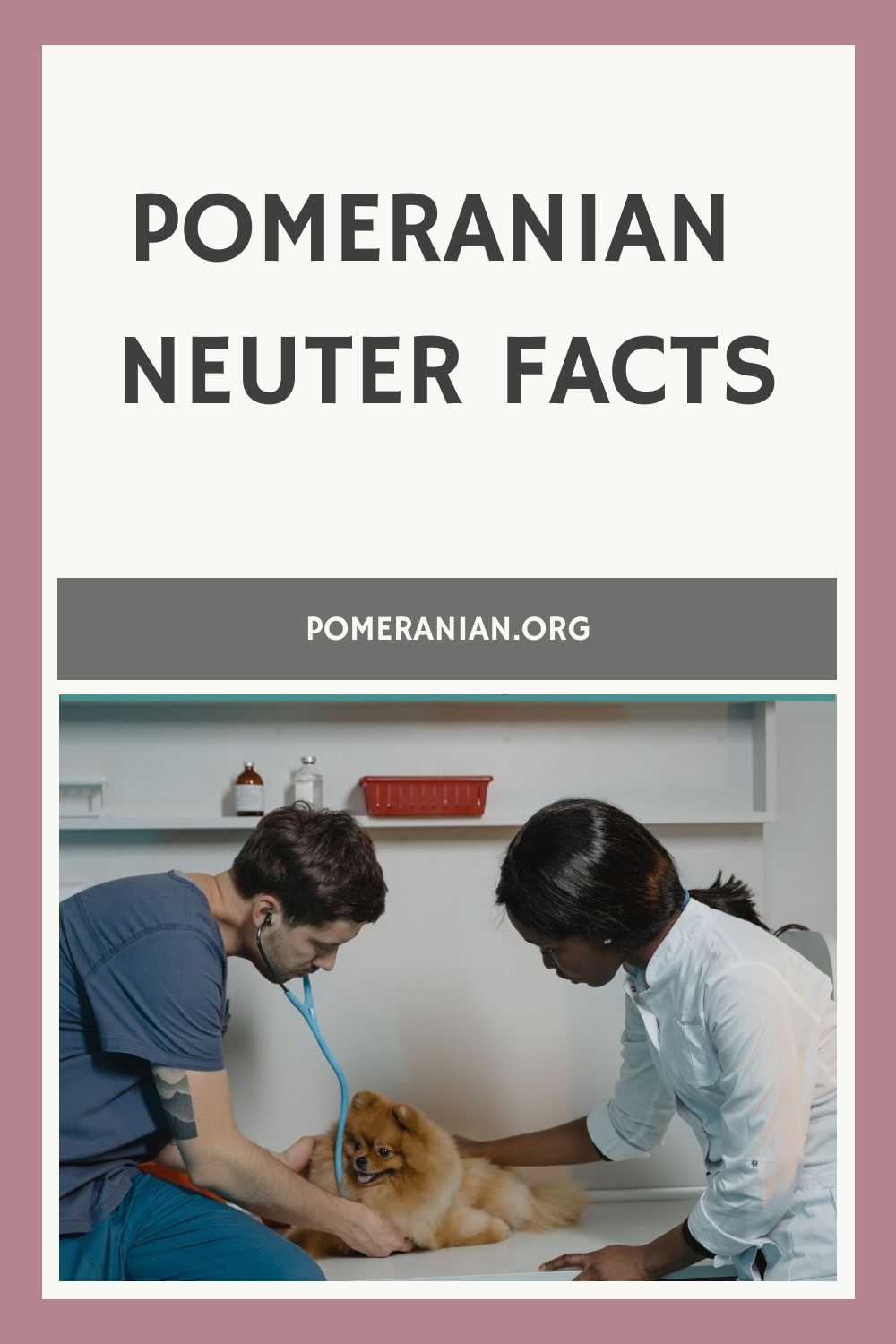Last Updated on 09/02/2024 by Denise Leo. Post first published on December 31, 2023.
Whether you have purchased a Pomeranian from a reputable breeder, or you have adopted your adorable canine, the most critical decision to make is when to neuter your family member. I wouldn’t say I liked the idea of neutering my first Pomeranian, but I was comforted that he would live a longer, healthy life due to me doing so.
Pomeranian Neutering Pros and Cons
Over the years, numerous myths have surfaced related to the reproductive needs of Pomeranians. The main myths are that males become sissies while spayed females become fat.
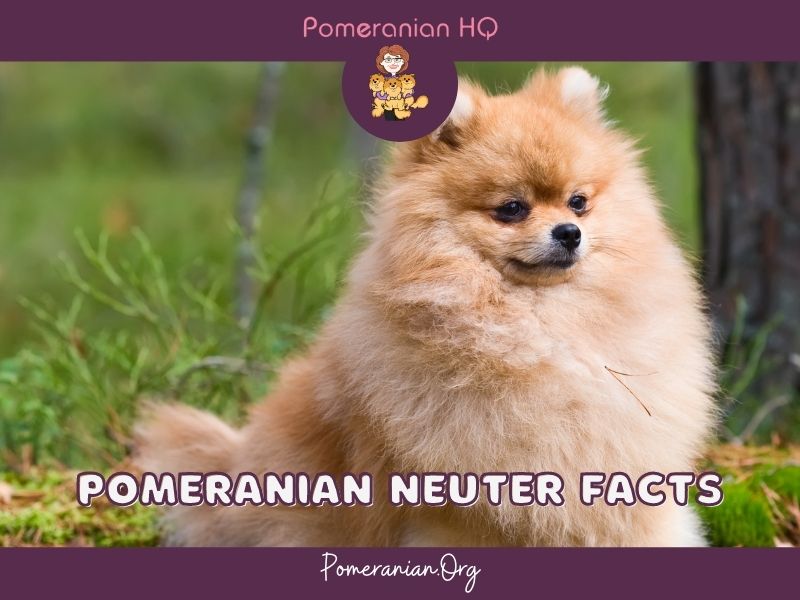
What are the Benefits of Spaying a Female Dog?
Females are more likely to become better pets if they’re not enduring estrus (aka oestrus/the heat cycle) regularly every 6-9 months.
Such cycles bring hormonal changes that can lead to changes in personalities. Females that experience this estrus need to be quarantined to help avoid pregnancies. As females grow older, their heat cycles may cause their reproductive systems to have mammary and uterine cancers.
Some girl Pomeranians may have false pregnancies that are annoying to handle, as well as infections in their uterus that may prove fatal. Despite changes in hormones being caused by sterilization and being overweight, bitches and dogs don’t usually get fat only because they have been neutered or spayed.
Like other mammals, they gain weight from too little exercise, too much food, or if they have been programmed to be overweight.
Any gain in weight following surgical sterilization can be linked back to the changes in hormones. However, the problem will be intensified if you keep feeding your dog a diet that’s high in energy while he doesn’t need as much energy because he has achieved his correct adult size. If his food has extra energy, it turns into excessive fat on his body.
Pros and Cons of Desexing Male Dogs
Male Pomeranians tend to be much better pets, especially those with dominant personalities. They roam less and don’t mark their territory (including all furniture) as often. If you neuter your dog before he becomes an adult, his desire to force his dominant personality over family members becomes less frequent.
Your Pom will be healthier overall, and because he’s neutered, his risk of testicular cancer is zero.
** Essential note: If you neuter your Pom, he’ll produce much lower testosterone, but the hormone isn’t completely eliminated. So, any dog that has been neutered, particularly if his character is rather dominant, may still roam and be assertive or aggressive.
Many owners heavily rely on the neutering process to fix problems with their dog’s behavior. However, they must train their dog to behave just the same, regardless of whether he’s in public or at home, so they can’t be lazy.
Possible Disadvantages of Desexing of Male Pomeranian
Like female spaying, male Pomeranians may also face issues, including obesity, because the castrated male Pomeranian endocrine system works differently. Hormones like thyroid get lowered and result in more obesity in male Pomeranians. In such cases, you need to treat Pomeranian hypothyroidism with medication after neutering to prevent rapid weight gain.
Neutered dogs are more prone to develop dementia and bone problems.
Like spaying, a veterinarian performs neutering with general anesthesia, and it may be possible that your male Pomeranian may also face some health complications associated with general anesthesia. But these complications are not fetal, and your veterinarian may control them with some therapeutics.
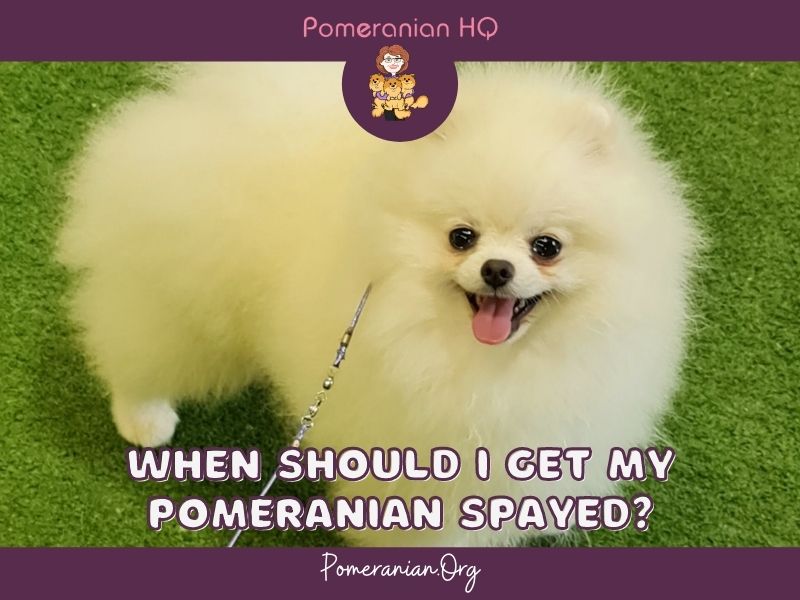
11. Benefits of Having Your Pomeranian Neutered:
The Biggest Reason is Health Issues
The biggest reason you neuter your Pomeranian is to give him a happier, longer, healthier life. It’s because he’s much less likely to suffer from diseases and infections such as prostate cancer and fatal conditions, including testicular cancer. If he hasn’t had the procedure and you don’t notice that he has problems in time to get him treated by the vet, he may lose his life.The Procedure
The vet will put him under an anesthetic so he won’t feel any pain. Ideally, it needs to be done when he’s approx. Six months old and certainly before adulthood. He can be checked more easily and thoroughly while asleep because he can’t move around. Also, request the vet to check that the puppy’s teeth are fine and extract any baby teeth still there.Age and Diseases
The older a Pomeranian gets, the more likely he is to contract any serious disease, including the ones already mentioned. By getting him neutered, he avoids facing common prostate hyperplasia (a disease that causes his prostate to become larger than normal). Neutering is the ONLY way to avoid all diseases. After his testicles are removed, he can’t get these diseases, so he’ll enjoy a much longer life. Female Pomeranians who are not spayed are at risk of mammary glands and other tumors.Toilet Training
Desexing often helps with undesirable habits like marking and assists with toilet training.An Affectionate Companion
Before neutering, many dogs aren’t very friendly. Despite Poms being cuddly and very friendly, one can come across one not keen on cuddling. The decision to neuter him can make him more caring, affectionate, and loving.Overall behavior Changes
You’ll be amazed how different your Pomeranian’s behavior will be after neutering.
He won’t keep on urinating in your home, trying to mark his particular territory. He won’t “hump” or “mount” everything in sight because his focus will be altered. Neutered Pomeranians are generally better focused and not distracted by the presence of Poms that haven’t been fixed. This means they’re much easier to train and will behave better outside the home. Many dogs try to escape because they have the urge to mate, and until yours is neutered, he’ll be one of them. However, if he’s out of your sight for a second, he may hurt himself because he can be quick. Running in front of a car or truck is easy and takes a moment. Neuter your Pomeranian, and you’ll protect him because he won’t feel the urge to escape and roam the neighborhood. You won’t need to worry about him doing just that.Biting is Less Likely
Pomeranians are usually calmer after neutering after the operation, so the likelihood of him biting is almost zero. Some unneutered dogs have unfriendly personalities and may bite without provocation. They’re often quick-tempered and will often start a fight. After your Pom has been neutered, for some dogs, it’s like waving a magic wand and saying, “Presto!” his negative behavior disappears like magic.You’ll Prevent Trouble Around the Home
If a male Pom is keen to mate, there are a few things he may do, including:
• Digging holes around your garden.
• Breaking things in your home if he feels trapped and can’t escape.
• Looking for ways to escape so he can locate a mate. This can be incredibly dangerous because he may dart across the road and get hit by a car, be attacked by a bigger dog, or get hurt somewhere he won’t be easily found.You’ll Save Money
Neutering isn’t cheap, but if you breed your Pomeranian and keep the litter, you’ll be spending large sums of money on items such as vet checks, vaccinations, bedding, food, registration, etc. Medical bills can be astronomical over the years. Owning a neutered dog is far cheaper than an entire dog.Limit Overpopulation of Dogs
Sadly, there are millions of cats and dogs without loving homes. Strays may breed and produce litter they can’t look after. The puppies get exposed to the world and are vulnerable to illnesses and accidents, as well as losing their lives easily. The story is the same with adult strays. Neutering is the safe, smart way to care for him.Not all Pomeranians Should Be Bred
Unless you are a registered breeder, you need to think long and hard before committing to breeding your Pomeranian. Pomeranians are notoriously hard to breed and are called the heartbreak breed by experienced breeders.
When to Neuter a Pomeranian Puppy?
Let your vet be the guide because every dog is different. Age, sex, and health are the main factors governing the best age to neuter a Pomeranian. Poms should normally be done when between 5 and 9 months old. Your Pomeranian should be neutered around puberty if possible.
When Should I Get My Pomeranian Spayed?
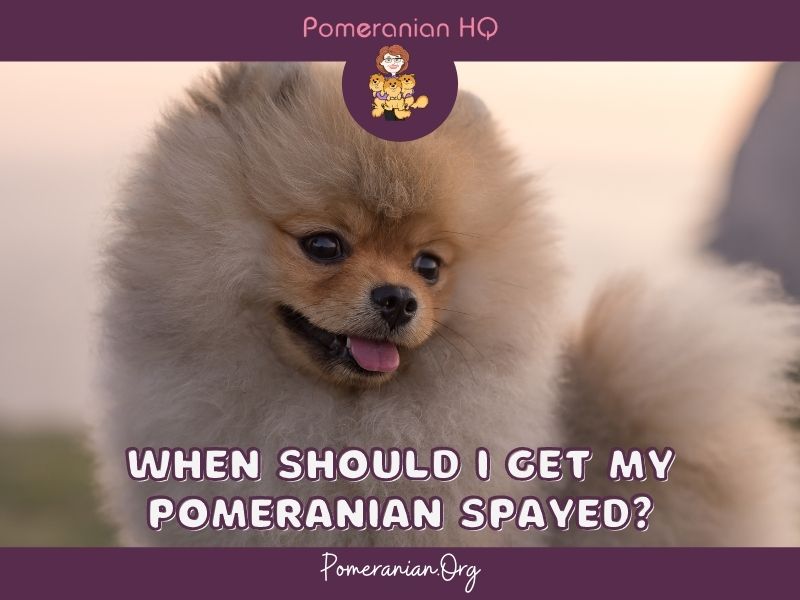
It’s a question that most female dog owners will eventually have to answer. Some believe that when it comes to when there is no best time, they can wait until the animal is in heat for the first time. But this blog post would like to argue otherwise.
We’ll discuss when you should get your female Pomeranian dog spayed and why it is such an important thing to do! Desexing a female dog is referred to as spaying her.
Best Age to Spay a Pomeranian Puppy
For small toy dogs like Pomeranians, the best time to get a female Pomeranian spayed is when they are between six and seven months old. I will explain why it’s such an important thing to do when you have a toy-breed dog like this one.
Small dogs do not need the hormones for development like larger dog breed dogs.
After your female Pomeranian has reached puberty, she should be spayed as soon as possible before her first heat cycle. Sometimes, Pomeranians have retained baby teeth.
These baby teeth can usually be removed simultaneously as desexing, thus saving the risks associated with two anesthetics.
If your Pomeranian has already had her first heat cycle, you should consider spaying approximately eight weeks after her heat has finished.
Pros and Cons of Spaying Before First Heat
The benefits usually outweigh any risks. Spaying before the first heat is best when spaying a female dog.
Spayed dogs are less likely to develop reproductive cancers (mammary cancer ) later in life.
Can a Dog Be Spayed When She is in Heat?
Yes, but it is not recommended, as the surgery becomes much more complicated when your Pomeranian is in heat. The risks include excessive bleeding and a higher chance of infection.
Can You Spay a Dog While Pregnant?
Many people say that dogs cannot be spayed while pregnant–but many veterinarians will perform the procedure anyway. The surgery terminates an existing pregnancy by removing both ovaries and the uterus.
Can a Dog Get Pregnant After Being Spayed?
The spaying surgery will prevent dogs from having further heat cycles and remove all risks of pregnancy.
Can Spaying my Pomeranian make them Fat?
A common concern with spaying is whether it will lead to obesity. But the answer is no.
Spaying female dogs does not make them fat, but feeding your Pomeranian unhealthy foods and not exercising her can cause her to become obese, which can cause serious disease and other health issues.
How do you prepare a Pomeranian for neutering or spaying?
Your veterinarian must confirm the health status of the Pomeranian before surgery. This is because surgery involved in neutering or spaying is an elective procedure.
But remember, you need to stop giving food to your pup before surgery. It is essential because feeding before surgery may lead to nausea or vomiting during the induction of anesthesia.
Care and What to Expect After Spaying or Neutering?
You need to restrict the activity of the Pomeranian for 7-10 days to avoid suture breaking or bleeding problems.
Provide a soft diet for at least three days after surgery and complete post-operative care with painkillers, antibiotics, and healing creams (as your Vet suggests).
You can expect your dog to eat less than normal immediately after surgery, but after one week, the situation will change, and the Pomeranian will move to normal feed. Normal post-operative recovery after spaying or neutering can take 8-10 days.
Advantage to Spaying a Dog after their First Heat
The benefits of spaying small dogs like the Pomeranian before their first heat outweigh any advantages of spaying after their first heat.
Spayed female dogs are less likely to suffer from mammary tumors and uterine infections when they age.
Neutering a female Pomeranian is called spaying, and this operation is a little more invasive and complicated than the procedure for a male dog. Female Pomeranian puppy owners should ask their vet when to spay a puppy.
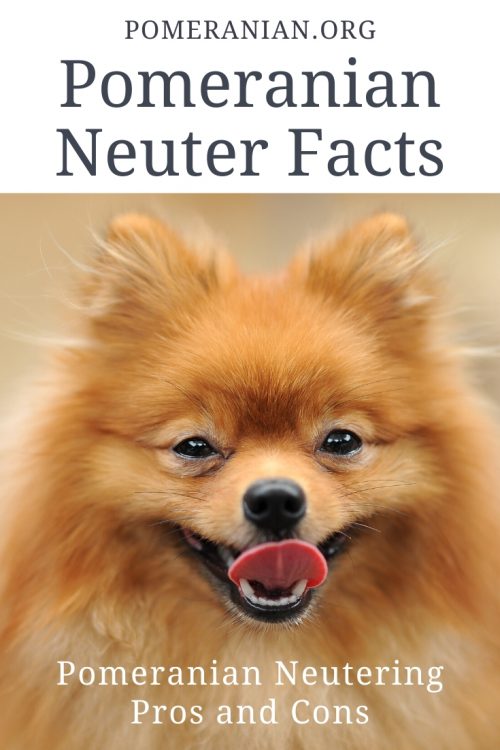
Possible Complications from Neutering
Complications may occur, but they’re rare. The more common complications include:
- Slow recovery process.
- Difficulty in controlling their urination.
- Bleeding.
- Infections.
- Negative side effects caused by the anesthetic.
- Problems in the urinary tract.
How Much Does it Cost to Neuter a Pomeranian?
The cost of neutering your Pomeranian will depend on the age and weight of your dog. The average fee is around $500, but it can vary depending upon whether you are neutering a male or female puppy, where you live, and whether or not there are any other procedures done at that time, like teeth cleaning, which may increase costs up to $1500.
Male puppies require less complicated surgery than females, so neutering them usually costs less.
Pomeranian Neuter Summary
In conclusion, the decision to neuter a Pomeranian involves weighing numerous factors and understanding the pros and cons of dogs of different ages. Pet owners must recognize that fixing at the right time can offer significant health benefits, such as reducing the risks of breast cancer in female Poms and heart disease in older dogs.
It also diminishes the chances of uterine infections and joint disorders like hip dysplasia. On the behavioral side, neutering can help mitigate behavioral problems commonly seen in intact male dogs and females, especially those related to territorial and mating behaviors.
However, pet owners should also be aware of the health risks associated with the surgical procedure, particularly in older dogs or those with pre-existing conditions.
It’s important to consider the potential for complications and the impact on the overall health and well-being of the dog. Recent research also suggests that neutering, especially at a very young age (months of age), might be linked to certain health issues, so timing is a key aspect to consider.
For those not planning to breed their Pomeranians and wanting to avoid an unplanned litter of puppies, neutering is a good idea. It also supports broader animal welfare goals, helping reduce the number of pets in animal shelters.
Each pet owner must make the best decision for their dog, considering their pet’s specific health needs, lifestyle, and risks. In some cases, consulting with a veterinarian might provide more personalized advice, especially for intact females, older dogs, or those dogs with specific health concerns.
Ultimately, neutering is a decision for various reasons, including health, behavior, and social responsibility. For many, the advantages of neutering outweigh the negatives, making it a good luck move for the long-term well-being of their Pomeranian.
The key is to make an informed choice, considering recent research, the dog’s age, and individual health circumstances. This approach ensures pet owners make the best decision for their beloved furry family members.
Neutering a Pomeranian provides many positive benefits, all aimed at improving his overall health. He’s protected from several potentially fatal maladies, and it also helps the Pom live a longer life. His behavior usually improves quite a lot. Like with anything, complications may happen, but are rare.
Disclaimer: The Content is not intended to be a substitute for professional veterinarian advice, diagnosis, or treatment. Always seek the advice of your veterinarian with any questions you may have regarding your dog’s medical condition. Never disregard professional advice or delay in seeking it because of something you have read on ANY website.
N.B. This article regarding Pomeranian health issues was written in consultation with our resident veterinarian.
Dr. Muqeet Mushtaq
DVM, University of Animal and Veterinary Sciences, 2019
MSc. (Hons.) (Animal Breeding & Genetics), University of Agriculture Faisalabad, 2021
Copyright Pomeranian.org. All Rights Reserved.
References and Further Reading:
Official Standard of the Pomeranian (AKC). American Kennel Club, 2011.
English Kennel Club Pomeranian Breed Standard, 2017.
Denise Leo, The Pomeranian Handbook.
